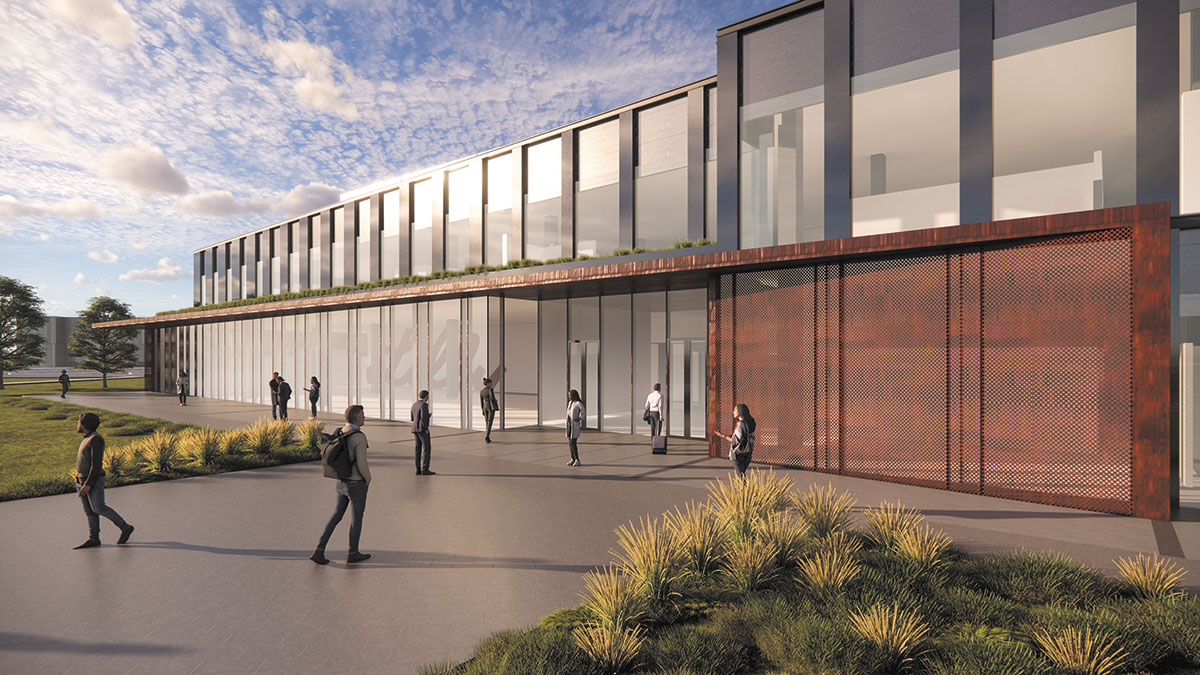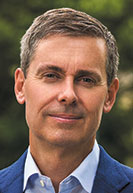Subscriber Benefit
As a subscriber you can listen to articles at work, in the car, or while you work out. Subscribe Now
The newest addition to Eli Lilly and Co.’s manufacturing site in Lebanon is substantial by any measure: seven large buildings spanning 1.2 million square feet, or more than 15 football fields in a row, including end zones.
The new facility dubbed the Lilly Medicine Foundry is a small village unto itself, with areas for offices, research and manufacturing. It’s a project on a huge scale—at a cost of $4.5 billion.
But the main reasons the Indianapolis-based drugmaker is spending billions of dollars on the massive project boil down to two words that can fit on a small piece of paper, rolled up in a medicine bottle: volume and complexity.
That’s the state of Lilly’s all-important pipeline lately, which the company is counting on to drive growth and deliver treatments and cures for patients.
In recent years, the company has seen dizzying growth in its pipeline for a wide range of diseases, from breast cancer and diabetes to Alzheimer’s disease and cardiovascular disease. At the end of last year, Lilly had more than 60 experimental medicines or new medical indications in its pipeline. That’s nearly double from two decades ago.

And the medicines are getting more complex every year. In past years, many drugs came in just one form, or modality, such as tablet or injection. But because treatments today include genetic medicines used in gene therapy for such complex diseases as blood cancer and spinal muscular atrophy, the medicines can come in a head-spinning array of multiple modalities. One example is an antibody plus a small molecule. Or a new class of radiopharmaceutical cancer drugs combines a targeting molecule that delivers radiation directly to cancer cells.
“So when you think about the volume and the complexity, that’s why we needed to create a facility of this scale,” Dr. Dan Skovronsky, president of Lilly Research Labs, said at an Oct. 2 press conference.
Lilly’s latest investment comes on the heels of three earlier rounds of manufacturing investment at the LEAP Research and Innovation District in Boone County for a total of $13.5 billion, making the site one of the largest capital projects in Indiana history.

Lilly CEO David Ricks said the company was undertaking “the most ambitious manufacturing agenda and expansion agenda” in its 148-year history.
“We’re not aware of another investment like this in the world,” he said at the press conference. “It’s really a unique moment for the industry, and the goal, of course, will be to create a reliable supply of clinical trial material but also improve the processes and efficiency of our manufacturing production systems and our other sites around the world.”
Manufacturing drugs
All that spending, in other words, is meant to allow Lilly to manufacture drugs quickly and get them to pharmacies and patients without delay. That would stand in sharp contrast to the supply shortfall that hampered Lilly earlier this year, when it could not make diabetes treatment Mounjaro and obesity treatment Zepbound fast enough.
The skyrocketing demand was caused, in part, by Lilly’s research that showed the active ingredient in both drugs, tirzepatide, helped overweight patients lose up to 26% of their body weight over 84 weeks.
Patients and doctors say the findings have been quick to catch on. But the huge demand for both drugs caused shortages that resulted in many patients having to go without their medicine.
Last week, the U.S. Food and Drug Administration announced the shortage of both drugs was over. Mounjaro had been in short supply since shortly after its introduction in 2022. Zepbound also has been in limited supply since being approved less than a year ago.
Lilly is holding back launches of Zepbound in about 40 countries until the company gets more supply ramped up, Ricks said at the press conference.
“This site will work on that problem, as well,” he said.
If Lilly can keep up with demand, the company could see $50 billion in total sales by 2028, analysts say. Last year, Lilly rang up $34.1 billion in total sales. Lilly has 11 obesity drugs in its pipeline, plus experimental medicines for numerous other diseases that have defied researchers for decades, including Alzheimer’s disease and Parkinson’s disease.
Lilly’s newest investment at its Boone County site is not even a manufacturing plant. The foundry is meant to deal with two challenges: finding ways to make medicines better and faster from the test tube to full-scale production and creating batches of experimental medicines for patients in clinical trials.
Neither is a small task. It generally takes a decade or more to research and develop a drug, including all the testing and approvals.
And testing drugs in humans is a monumental job. Lilly now has about 100,000 patients in clinical trials, equivalent to the population of the cities of Carmel or South Bend.
“That’s not a small amount of material we supply with medicines as we study our products and prepare them for market,” Ricks said. “This site will allow us to scale up quickly, not relying on others to do so, and get our clinical trials running and get medicines to patients faster.”
Lilly now outsources some of those functions to other companies, which can lead to delays in drug development. Bringing them back in-house can speed up production, Lilly said.
Technologies developed at the foundry will be transferred to Lilly’s manufacturing sites for full-scale operation. The foundry is scheduled to open in 2027.
Meanwhile, more than a dozen other buildings are rising from the ground at Lilly’s Boone County manufacturing site.
Lilly broke ground at the site last year, and hundreds of construction workers are now converting the rugged area from farmland into a massive industrial complex that will make active pharmaceutical ingredients for multibillion-dollar Lilly drugs, along with cell and gene therapies.
The latest round of investment by Lilly will stretch the 600-acre footprint by about 200 acres, expanding it west of Interstate 65 for the first time.
Lilly grows
So far, the state has committed a total of $1.7 billion in tax incentives to Lilly for all phases of the site, including the foundry. It is also supporting the foundry site with improvements for roads, water, electricity and other utilities.
Analysts are betting the investments will pay off. Steve Scala, an analyst for TD Cowen, is predicting that Lilly’s operating margins will increase from 38.8% last year to 47.7% in 2030.
“The margin expansion is driven by a mix shift to newer products as well as productivity benefits including manufacturing efficiencies, fewer leadership positions, and sales force reductions, which are expected to increase productivity and simplify Lilly’s global commercial operation,” he wrote in a note to clients this week. He has a buy rating on the stock.
Evan David Seigerman, an analyst with BMO Capital Markets, told clients in a note last week that Lilly’s new chief financial officer, Lucas Montarce, has identified manufacturing as a priority.
“We get the sense that his goal is to grow the manufacturing footprint worldwide to ensure that every patient gets the right product when needed,” wrote Seigerman, who has a buy rating on Lilly stock.
Lilly’s expansion is expected to add 400 full-time jobs for highly skilled workers, including engineers, scientists, operations personnel and lab technicians. Today, Lilly has more than 12,000 employees in Indiana, or 30% of its global workforce.
But it’s hiring scientists and researchers elsewhere, as well. In April, Lilly opened a $700 million research and development site in Boston, dubbed the Lilly Seaport Innovation Center.
The center, with about 200 scientists, will focus on developing RNA- and DNA-based therapies, as well as discovering new drug targets to create new medicines for diabetes, obesity, cardiovascular diseases, neurodegeneration and chronic pain.
And last month, Lilly announced plans to spend $1.8 billion on two of its manufacturing sites in Ireland to boost production of medicines for Alzheimer’s disease, diabetes and obesity.
But in terms of sheer dollars, nothing can match the investment Lilly is making in Indiana at $13.5 billion and counting. And Ricks said the investment will help the company keep its Indiana personality while helping hundreds or thousands of Hoosiers looking for research jobs.
“We’re committed to strengthening our roots here,” Ricks said, “fostering local talent, working with our partners in education, driving scientific activity at this new facility.”•
Please enable JavaScript to view this content.

